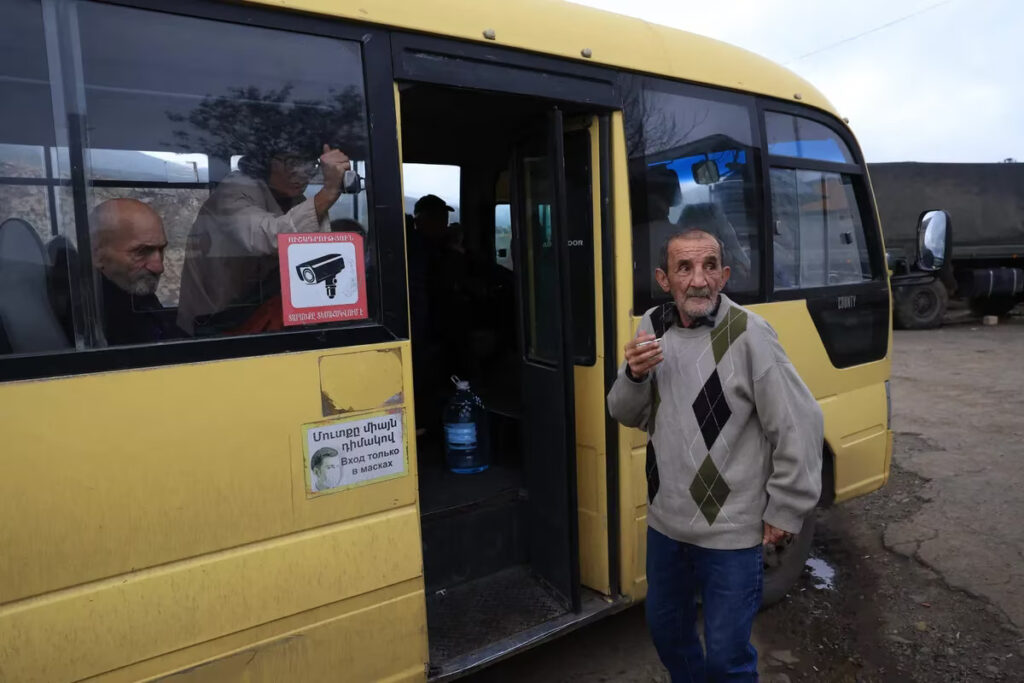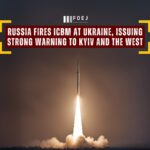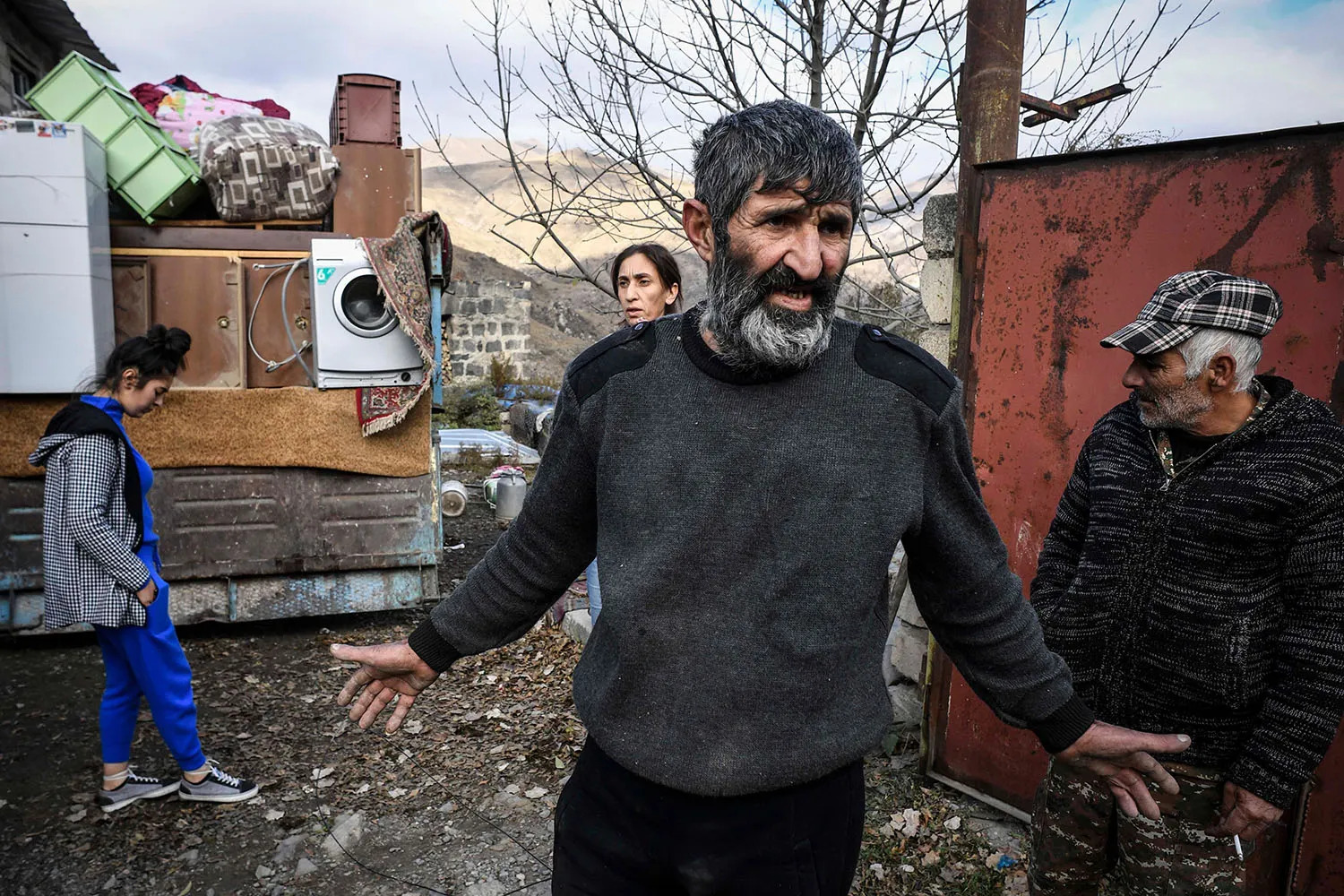Nagorno-Karabakh, a disputed territory in the South Caucasus, has witnessed decades of war and bloodshed between Armenia and Azerbaijan. The region, which is internationally recognized as part of Azerbaijan but was largely controlled by ethnic Armenians until 2023, has been the scene of a recent Azerbaijani military offensive that forced tens of thousands of Armenians to flee their homes.
The video report by AFP shows the desolate and devastated landscape of Nagorno-Karabakh, where abandoned villages, burned houses, and destroyed churches bear witness to the violence and destruction that took place.

One of the interviewees in the video Aram Grigoryan, who is a 58-year-old farmer and lives in the village of Karvachar says he has lost everything he had worked for in his life, including his house, his cattle, and his land. He says he does not want to leave his ancestral home, but he does not know what will happen to him and his family. He goes on to say that he feels betrayed by the Armenian government, which signed a ceasefire agreement with Azerbaijan in September 2023 that ceded most of Nagorno-Karabakh to Baku.
The video report also shows some of the Azerbaijani soldiers who have entered Nagorno-Karabakh as part of the ceasefire deal. They are seen raising their national flag, celebrating their victory, and inspecting the captured areas. They say they are happy to return to their ancestral lands, which they claim were occupied by Armenia for decades. They say they are ready to coexist with the Armenians who remain in
The history of the Nagorno-Karabakh conflict is a complex and long-standin g one, involving ethnic, religious, and territorial disputes between Armenia and Azerbaijan.
Geographically, Nagorno-Karabakh is a mountainous region in the South Caucasus, which is internationally recognized as part of Azerbaijan, but has a majority Armenian population. The region has a rich and diverse cultural and religious heritage, with ancient Christian monasteries and mosques coexisting in the same area.
The region was part of the Persian Empire until the early 19th century, when it was annexed by the Russian Empire. Under Russian rule, the Armenians enjoyed more privileges and rights than the Azerbaijanis, who were mostly Muslim Turks. This created resentment and tension between the two groups.
After the collapse of the Russian Empire in 1917, both Armenia and Azerbaijan declared independence from the USSR and claimed Nagorno-Karabakh as their own territory.
A series of wars and massacres ensued, resulting in thousands of deaths and displacements on both sides. The conflict was temporarily resolved in 1921, when the Soviet Union established control over the region and granted it a degree of autonomy within Azerbaijan.
During the Soviet era, the Armenians of Nagorno-Karabakh repeatedly demanded to join Armenia, but their requests were denied by Moscow. The situation worsened in the late 1980s, when the Soviet Union began to disintegrate and nationalist movements emerged in both Armenia and Azerbaijan.
In 1988, Nagorno-Karabakh voted to secede from Azerbaijan and join Armenia, sparking a violent backlash from the Azerbaijani authorities and population.
A full-scale war broke out between Armenia and Azerbaijan in 1991, after both countries declared independence from the Soviet Union. The war lasted until 1994, when a ceasefire agreement was signed with the mediation of Russia, France, and the US.
The agreement left Nagorno-Karabakh under the control of Armenian-backed separatists, who declared an independent republic that was not recognized by any country. The war claimed about 30,000 lives and displaced more than a million people.
The ceasefire agreement did not resolve the underlying issues of the conflict, and sporadic clashes and skirmishes continued to occur along the border between Armenia and Azerbaijan. Both sides accused each other of violating the ceasefire and committing human rights abuses.
In September 2020, a major escalation of violence erupted in Nagorno-Karabakh, with both sides using heavy artillery, drones, missiles, and tanks. The fighting lasted for six weeks and resulted in more than 6,000 deaths and tens of thousands of refugees.
Turkey openly supported Azerbaijan with military aid and diplomatic pressure, while Russia tried to broker a ceasefire between its two former Soviet allies.
In November 2020, Armenia and Azerbaijan agreed to end the hostilities after Azerbaijan captured several strategic towns and territories in Nagorno-Karabakh. The peace deal, which was brokered by Russia, involved Armenia ceding most of Nagorno-Karabakh to Azerbaijan, as well as some adjacent areas that were occupied by Armenian forces since 1994.
Russia also deployed peacekeeping troops along the new border to monitor the situation and protect civilians.
The peace deal was welcomed by Azerbaijan as a victory and a restoration of its territorial integrity, but was met with anger and protests by many Armenians who felt betrayed by their government and abandoned by their allies.
The fate of Nagorno-Karabakh’s Armenian population remains uncertain, as many have fled their homes or face discrimination and harassment under Azerbaijani rule. The cultural and religious heritage of Nagorno-Karabakh is also at risk of damage or destruction due to the war.
The current situation in Nagorno-Karabakh is very tense and uncertain, as the Nagorno-Karabakh authorities have ordered the dismantling of the region’s state institutions by the end of the year, saying that the separatist state will cease existing as of January 1, 2024.
Nagorno-Karabakh is a disputed territory in the South Caucasus, which is internationally recognized as part of Azerbaijan, but has a majority Armenian population. The region has its own de facto government, which is backed by Armenia, but not recognized by any country.
Since December 2022, Nagorno-Karabakh has been under blockade by Azerbaijan-backed activists, who claim to be protesting against illegal gold mining in the region. The blockade had prevented the import of food and other supplies, causing a humanitarian crisis for the residents of Nagorno-Karabakh.
Nazeli Baghdasaryan, the press secretary to Armenian Prime Minister Nikol Pashinyan, said on Saturday that 100,417 people had arrived in Armenia from Nagorno-Karabakh, which had a population of approximately 120,000 before Azerbaijan reclaimed the region in a lightning offensive last week.
According to an Aljazeera report, It’s nearly an exodus like situation, since more than 100,000 people have fled Nagorno-Karabakh looking for safety and peace.
Azerbaijan’s Ministry of Foreign Affairs, however, strongly rejected the accusations of ethnic cleansing of a state, saying the mass migration by the region’s residents is “their personal and individual decision and has nothing to do with forced relocation”.









